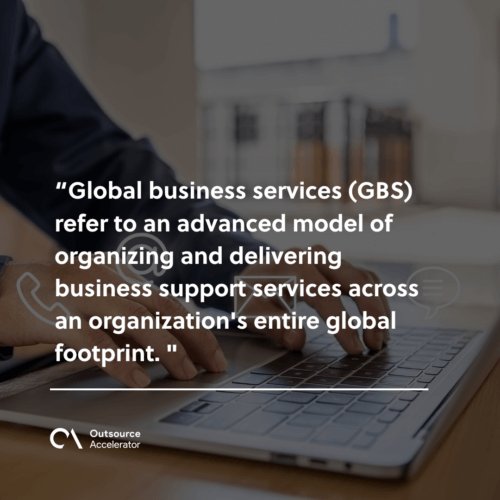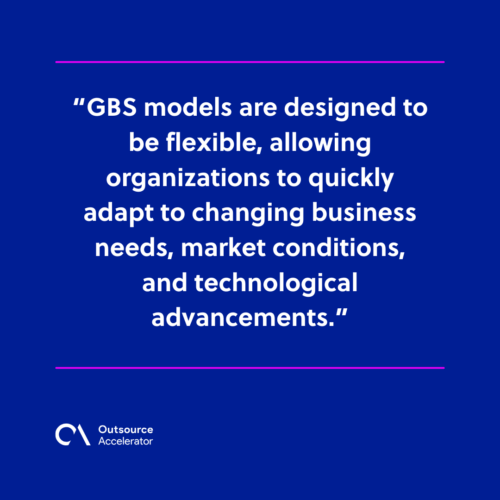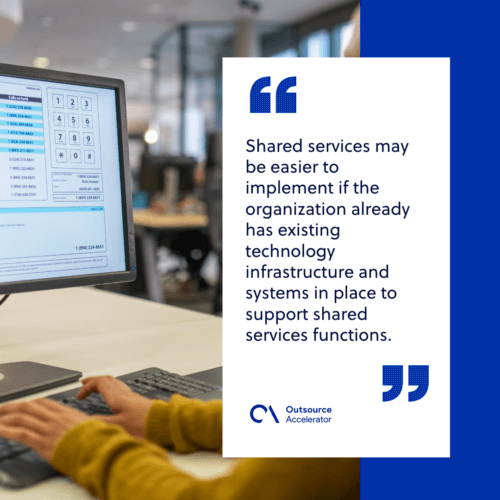Global business services vs. Shared services: A thorough comparison

There exist many solutions today that help businesses streamline their operations and optimize resources. Two prominent models that have gained traction in the corporate world are global shared services and shared services.
While both solutions aim to centralize and standardize support functions, they differ significantly in scope, approach, and strategic impact.
Understanding these differences is crucial for organizations looking to adopt the right approach for their unique needs.
In this article, we’ll examine the intricacies of global shared services vs. shared services, exploring their key characteristics, advantages, and practices to select the right fit.
What are global business services?
Global business services (GBS) refer to an advanced model of organizing and delivering business support services across an organization’s entire global footprint.
GBS typically consolidates various functions such as finance, human resources, IT, procurement, and other shared services into centralized units. These units serve multiple business units or regions around the world.
Global business services’ primary goal is to drive standardization, efficiency, and cost savings. They do this by leveraging economies of scale, best practices, and advanced technologies.

Key characteristics of global business services
Global business services is characterized by several key features that distinguish it from traditional shared services and other operational models.
Here are the primary characteristics:
- Global reach – It operates on a global scale, serving multiple regions, business units, or functions across the organization’s worldwide operations.
- Centralization – It centralizes business support functions to eliminate redundancies, improve coordination, and enhance efficiency.
- Standardization – GBS focuses on standardizing processes, systems, and practices to ensure consistency and quality across different regions or business units.
- Strategic focus – It takes a more strategic approach to business support services, aligning them with the organization’s overall objectives and actively contributing to its growth and competitiveness.
- Technology-enabled – GBS leverages advanced technologies such as automation, analytics, and cloud computing to enhance productivity, drive innovation, and deliver value-added services to the business.
- Customer-centric – GBS places a strong emphasis on meeting the needs and expectations of internal stakeholders and often incorporates feedback mechanisms to continuously enhance service delivery.
Benefits of global business services
Global business services offer numerous benefits that can significantly enhance an organization’s operational efficiency, strategic alignment, and overall performance.
Here are the key benefits:
Cost efficiency
Global business services can achieve significant cost savings through economies of scale, reduced duplication of efforts, and streamlined processes.
By consolidating and standardizing business support functions, it can lead to improved financial performance for the organization.
Improved service quality
Global business services promote the adoption of best practices, standardized processes, and quality metrics.
This approach results in enhanced service delivery and consistency across different business units and regions, leading to higher customer satisfaction and better business performance.
Strategic alignment
Global business services enable a more strategic approach to business support services and align them with the organization’s overall strategic objectives. It often shifts the focus from mere cost reduction to value creation.
This alignment can lead to better decision-making, more efficient resource allocation, and improved competitiveness in the marketplace.
Talent development and retention
Global business services offer opportunities for talent development and career advancement. Employees have access to diverse experiences and cross-functional roles within a global framework.
This can lead to higher employee satisfaction, retention, and a more diverse and skilled workforce.
Enhanced agility
GBS models are designed to be flexible, allowing organizations to quickly adapt to changing business needs, market conditions, and technological advancements.
Additionally, the ability to scale services up or down based on demand helps in managing resources more effectively.

Strategic partnerships and collaboration
Encouraging collaboration across different parts of the organization and with external partners enhances knowledge sharing and drives better outcomes.
GBS also lets companies leverage external expertise. Partnering with third-party vendors and service providers brings in additional expertise and capabilities.
Challenges with global business services
Global business services offer numerous advantages, but it also presents several challenges that organizations must address to realize its full potential.
Here are the key challenges:
Cultural differences
Managing a global workforce involves addressing diverse cultural norms and practices, which can impact team cohesion and service delivery.
Disparities in language and communication styles can cause miscommunication and impede productive teamwork. It may require implementing multilingual language support or adopting new communication technology or processes.
Security risks
Using global business services can create security risks as sensitive information may be shared with employees who may not be physically located at the same site as the company.
This means that companies need to ensure that their data is secured through processes such as access restrictions, data encryption, and backups.
Quality control
Global business services may not always meet the expected quality level. This could be due to communication barriers or a lack of standards in the services provided or processes used in delivering those services.
Integration with internal operations
Global business services may not be well integrated with a company’s internal operations which could cause an increase in inefficiencies and errors.
Companies need to invest time and resources in ensuring that their global business services are integrated with their internal processes and procedures.
What are shared services?
Shared services refer to a model of providing support services to different business units or departments within an organization from a centralized unit.
This model is designed to create efficiencies by consolidating and standardizing support services into a single shared services center.
Its goal is to eliminate redundancies, reduce costs, and improve service delivery by providing a standardized and consistent level of support across the organization.

In many cases, shared services are established as standalone units within an organization. They may be located in one geographic region, or a network of distributed shared service centers may be established to support different regions or business functions.
However the organization chooses to structure its shared services, it remains a popular approach for companies looking to scale their operations while managing costs effectively.
Shared services can be distinguished from outsourcing, which involves contracting out services to a third-party provider.
With shared services, the organization retains control over the service delivery process and can establish standard processes and performance metrics to ensure consistency and quality.
In contrast, outsourcing typically involves transferring ownership of a specific set of activities to an external provider, who is responsible for delivering the services.
Key characteristics of shared services
The following are key characteristics of shared services:
- Centralization – Shared services are characterized by centralization, wherein several business functions are consolidated into a single service delivery center, concentrating resources in one place.
- Cost-effective – Shared services can reduce costs by pooling resources and leveraging economies of scale.
- Performance measurement – It uses performance metrics to monitor service delivery and to enable continuous improvement, tracking metrics, process efficiency, and cost-effectiveness.
- Lean management – Shared services often adopt lean management principles to maximize efficiency and minimize waste. This includes eliminating bottlenecks and duplication and boosting service delivery through process optimization.
- Technology-enabled – This model leverages technology to enable effective service delivery, using software and tools to automate processes, standardize data, and manage workflows.
Benefits of shared services
Shared services offer several significant benefits that can enhance an organization’s efficiency, cost-effectiveness, and service quality.
Here are the key benefits:
Cost savings
Through the consolidation and standardization of business processes, shared services can achieve economies of scale and cost efficiencies.
By eliminating redundancies, sharing resources, and leveraging technology, organizations can reduce costs and focus resources on core business activities.
Enhanced service quality
Shared services allow companies to provide a consistent level of service quality across different business units or departments. This enables organizations to meet customer needs more effectively, improve customer satisfaction, and enhance their reputation.
Better talent management
Shared services enable companies to attract and retain top talent by offering career growth opportunities, specialized training, and a diverse range of roles. It leads to a highly skilled workforce that can drive innovation and productivity.
Improved data management
Shared services enable organizations to standardize data processes and centralize data management. This reduces the risk of errors and enhances data quality which, in turn, enables better-informed decision-making.
Better control and compliance
Centralized control over processes ensures better compliance with internal policies and external regulations. Also, shared services offer improved visibility and control over operations, which help identify and mitigate risks more effectively.
Challenges with shared services
While a worthwhile and effective model to apply, shared services have many drawbacks.
Here are some challenges companies that utilize shared services sometimes face:
Talent base and mindsets
A typical shared-services organization tends to focus on keeping the day-to-day operations. Its talent base may skew heavily towards individuals with ‘processing’ mindsets.
This makes it challenging to adopt digital capabilities due to the lack of proficiency in digital technologies and innovation.
Resistance to change
Many organizational changes are met with resistance from employees. Implementing shared services may lead to misunderstandings, lack of cooperation, and information sharing among departments.
Initial investment
Setting up a shared services center involves significant initial investments in technology, infrastructure, and training. Ensuring adequate resources for the transition phase can strain existing budgets and operations.
Process standardization
It can be challenging to strike the right balance between standardized processes and the need for customization to meet local or departmental needs.
Consistent service delivery across various regions and business units requires rigorous adherence to standards.
Factors for choosing between global business services vs. shared services
When deciding between global business services and shared services, several factors need to be considered to determine the most suitable operating model for an organization.
Some key factors to consider include:
1. Organizational size and complexity
A shared services model may be more suitable for smaller organizations with simpler structures and operations as it allows for a more focused approach to specific functions.
A global business services approach is better suited for larger, complex organizations with diverse business units and global operations. It can provide a more integrated and holistic approach to managing various functions.
2. Geographical footprint
Shared services are ideal for organizations with a localized or regional presence, as they can cater to the needs of specific regions or business units efficiently.
Global business services, meanwhile, are preferable for organizations with a global footprint and operations in multiple countries. The model enables centralized control and coordination across different regions.
3. Scope of functions
Shared services are suited for organizations looking to streamline and centralize specific functions like IT, HR, or finance. It aims to achieve cost savings and operational efficiencies.
GBS is suitable for organizations that require integration of multiple functions beyond shared services, such as IT, finance, procurement, and customer service. It aims to drive value creation and support business growth.
4. Strategic alignment
Shared services focus on operational excellence, cost reduction, and process efficiency. This makes it suitable for organizations with a priority on immediate cost savings and standardization.
GBS offers a more strategic approach. It aligns support services with business objectives, driving innovation, enhancing customer experience, and creating long-term value for the organization.
5. Technology readiness
Shared services may be easier to implement if the organization already has existing technology infrastructure and systems in place to support shared services functions.

The GBS model requires advanced technology capabilities and digital tools to enable seamless integration of diverse functions and global operations. It’s more suitable for organizations with a strong focus on digital transformation.







 Independent
Independent




